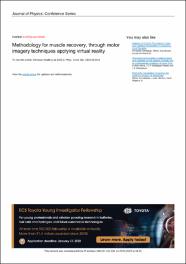| dc.contributor.author | Ovalle, Christian | es_ES |
| dc.contributor.author | Cordova-Buiza, Franklin | es_ES |
| dc.contributor.author | Linares, Oscar | es_ES |
| dc.contributor.author | Auccahuasi, Aly | es_ES |
| dc.contributor.author | Romero Echevarría, Martha | es_ES |
| dc.contributor.author | Meza, Sandra | es_ES |
| dc.contributor.author | Urbano, Kitty | es_ES |
| dc.contributor.author | Barrera Loza, Ana | es_ES |
| dc.contributor.author | Figueroa Revilla, Jorge | es_ES |
| dc.contributor.author | Bernardo, Grisi | es_ES |
| dc.date.accessioned | 2023-01-25T17:21:22Z | |
| dc.date.available | 2023-01-25T17:21:22Z | |
| dc.date.issued | 2022 | |
| dc.identifier.uri | https://hdl.handle.net/20.500.13053/7691 | |
| dc.description.abstract | “Recovery of movement is a long and hard process for patients. One of the most
common problems that occurs is the so-called ““phantom limb““, which induces the body to feel
strange due to the failure to use the injured limb. This process is due to the lack of use of the
leg that in most cases is fractured and the long recovery time, so the use of crutches makes the
body in conjunction with the brain understand that normal movement of the body is with the
leg suspended and always with the help of crutches. In the present work a technique for the
retraining of the brain is presented by means of which the brain is taught through the
presentation of images if it corresponds to the right and left side of the arms and legs. This
retraining makes it possible for the brain to understand the coordinated movement between the
arms and legs. In addition to the use of virtual reality, through the OCULUS GEST II lenses,
allowing maximum concentration, the results allow to improve the recovery time of patients,
the technique can be used both in rehabilitation centers and in the patient's own home patient.“ | es_ES |
| dc.format | application/pdf | es_ES |
| dc.language.iso | eng | es_ES |
| dc.publisher | Institute of Physics | es_ES |
| dc.rights | info:eu-repo/semantics/openAccess | es_ES |
| dc.rights.uri | https://creativecommons.org/licenses/by/4.0/ | es_ES |
| dc.subject | Virtual reality, imagery, muscle recovery, images, senses, relearning. | es_ES |
| dc.title | Methodology for muscle recovery, through motor imagery techniques applying virtual reality | es_ES |
| dc.type | info:eu-repo/semantics/article | es_ES |
| dc.identifier.doi | 10.1088/1742-6596/2318/1/012044 | es_ES |
| dc.type.version | info:eu-repo/semantics/publishedVersion | es_ES |
| dc.publisher.country | GB | es_ES |
| dc.subject.ocde | http://purl.org/pe-repo/ocde/ford#1.02.00 | es_ES |


